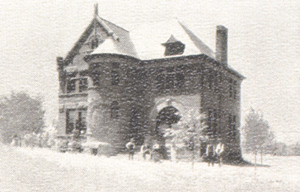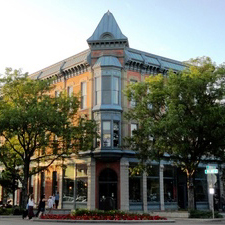Yesterdays in Fort Collins
Fort Collins and College c. 1916-1921
by Mabel H. Chapman

In 1916 the Colorado State University at Fort Collins was the Colorado College of Agriculture and Mechanic Arts. It was a federal land grant college, although the land was a gift of certain Fort Collins residents. Land Grant colleges were required to have an ROTC (Reserve Officers' Training Corps). The college was administered by the Colorado State Board of Agriculture. The board also administered two schools of secondary level called short courses. Many scattered communities did not have high schools. The counties provided elementary schools only. State law did not require children to school after their thirteenth birthday.
Fort Collins short course ran from October to March. It was a three year program. Basic high school subjects were taught. The girls took Home Economics. The boys had Agronomy and Animal Husbandry. They met in classrooms on the campus. For instance, the freshmen met on the floor, English Department staff had offices on the second floor, and the short course English classes were held in the third floor attic. The pupils found lodging and board in private homes. The other short course was held at Fort Lewis in southeastern Colorado. Fort Lewis had been a military post during the Indian wars. After the treaty with the Utes it was transferred to the board of Agriculture. Experiments were carried on. They were developing a type of wheat to be grown in the higher altitudes. Also a short course was conducted from April through September.
Both students and teachers were housed on the former military base. The large hospital became the dormitory for women and girls. The men stayed in the staff headquarters. Everyone ate in the mess hall. The most startling change one sees in Fort Collins is the establishments of so many fast food shops and lodging places on College Avenue. In 1916 there were no public eating or lodging places near the college. In fine old homes hostesses extended their dining areas and took a number of boarders who roomed in near-by homes. Some hostesses furnished both board and room. Mrs. Sheppard had at her table a number of the unmarried faculty. Coming by train from the south to Fort Collins one saw sugar beet fields. German Russian women and children were doing the stoop labor of harvesting the beets. Men were loading trucks with beets for delivery to the factory north of town.
A sixth grade teacher coming on the train from Denver said sympathetically, "Those poor children! All the work they will have to make up when the harvest is over!" During the season the Great Western Sugar Company had guided tours of their beet sugar factory. Near the beet factory were feeding pens. When the snow covered the grazing grounds in Wyoming the stockmen bought the sheep and lambs to these pens to be fed by the wastes from the sugar beet factory. On the college campus near the corner of Laurel and College Avenue grew the famous "silver spruce." The tree was in front of a building, but I am not sure of what the building was called. Main? Spruce Hall?
On April 9, 1917 the college student body returned from the spring break. World War 1 had been declared just three days earlier. The campus and the town had already felt the shock. ROTC students were already called to service, but they were still on campus. They were going to their instructors to ascertain the status of their credits, and to say goodbye. My freshman English class had 39 ROTC students. They had come to my class in uniform. This morning they came to my classroom one by one to turn in their notebooks filled with outlines and compositions. They came, not as students, but as soldiers to say goodbye. Town and college people became involved in activities to support the soldiers. The teacher of French started a class in French. Townspeople and college people attended but they soon realized learning a language took time, and so they found other activities.
Many rolled bandages for the Red Cross. Women who could knit made sweaters and taught others how to knit. Many sweaters were given for distribution by the Red Cross. Some mailed individual gifts of sweaters. Many sent gifts of baked goods. Other goodies were sent to soldiers. The young people of the Methodist Church formed gospel teams. The army had sent out a call for chaplains and the pastors of a number of neighboring churches in the farming areas had enlisted. A number of the laymen left in charge asked the gospel teams to conduct their Sunday services. I was on one such team, with two young men. We were sent to a Presbyterian Church north of Fort Collins. Many young men of the town enlisted. The unmarried faculty men whose classes had been depleted also enlisted. Others stayed on to the end of the semester before enlisting.
The college opened with a lower enrollment in September 1917. In the fall of 1918 an epidemic of Spanish Flu spread over Europe and the United States. Washington public buildings were closed. Schools and colleges all over the country were closed. Colorado Agriculture College closed in October. Classes re-opened in January 1919.
Random Memories
Seeing Mrs. Lory, wife of the president of the college, riding around the campus in an electric auto. Attending a football game between the Agriculture College and the University of Denver. The "Aggies" won. (Yes the U of D did have a football team in those days.) Learning that Professor Durward, Head of the Home Economics Department, was a descendent of Quentin Durward. I had thought that Quentin Durward by Sir Walter Scott was fiction. Visiting Mr. Espelin's florist shop. There were a number of sorority girls waiting for him to come from his greenhouse west of town with flowers for their party that evening.
An Early Incident-Hottel Fame
Shortly after arriving in Fort Collins I attended a party given by the young people of the Methodist church. A young man at the door greeted the guests. The girls were clustered around a table in the far corner of the room, arranging decorations and refreshments. I was introduced by my companion as Miss Hoddle. (Correct) I thought the first man repeated the name, until the next man asked me if I was related to the Hottels. Only I thought he said Hoddle. All the men gathered around and one after another had some story to tell about the Hottels, their mill, their business and also Mrs. Hottel's activity in the women's club. So until the girls rescued the men for refreshments, the conversation was the Saga of the Hottels.
1921
My husband and I lived in Fort Collins that year. At the northeast corner of Laurel and College was a butcher shop. Upstairs was a maternity home run by an obstetrical nurse. She had two large bedrooms for patients and a small delivery room stocked with supplies the doctor might need. Her own living quarters were back of these rooms. (Today the butcher shop is bicycle shop.) Otherwise the neighborhood around the college looked the same. Households, not necessarily the same ones, offered room and board. Mrs. Sheppard no longer had boarders. Her son, who had been a student in 1917, left for war with the first contingent. Now in '21 he was a member of the college faculty. He had brought a French bride home. Professor Coen of the English Department had gone to an eastern university to work for his doctor's degree. Jocelyn Wattles was back on campus working in the Drama Department. Mr. Espelin still had his florist business catering to both the town and college students. The "silver spruce" still stood.







